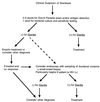Treatment of giardiasis
- PMID: 11148005
- PMCID: PMC88965
- DOI: 10.1128/CMR.14.1.114-128.2001
Treatment of giardiasis
Abstract
Giardia lamblia is both the most common intestinal parasite in the United States and a frequent cause of diarrheal illness throughout the world. In spite of its recognition as an important human pathogen, there have been relatively few agents used in therapy. This paper discusses each class of drugs used in treatment, along with their mechanism of action, in vitro and clinical efficacy, and side effects and contraindications. Recommendations are made for the preferred treatment in different clinical situations. The greatest clinical experience is with the nitroimidazole drugs, i.e., metronidazole, tinidazole, and ornidazole, which are highly effective. A 5- to 7-day course of metronidazole can be expected to cure over 90% of individuals, and a single dose of tinidazole or ornidazole will cure a similar number. Quinacrine, which is no longer produced in the United States, has excellent efficacy but may be poorly tolerated, especially in children. Furazolidone is an effective alternative but must be administered four times a day for 7 to 10 days. Paromomycin may be used during early pregnancy, because it is not systematically absorbed, but it is not always effective. Patients who have resistant infection can usually be cured by a prolonged course of treatment with a combination of a nitroimidazole with quinacrine.
Figures


References
-
- Reference deleted.
-
- Reference deleted.
-
- Abdi Y A, Gustafsson L L, Ericsson O, Hellgren U. Handbook of drugs for tropical parasitic infections. 2nd ed. London, United Kingdom: Taylor & Francis Ltd.; 1995. pp. 12–16.
-
- Addiss D G, Davis J P, Roberts J M, Mast E E. Epidemiology of giardiasis in Wisconsin: increasing incidence of reported cases and unexplained seasonal trend. Am J Trop Med Hyg. 1992;47:13–19. - PubMed
-
- Addiss D G, Juranek D D, Spencer H C. Treatment of children with asymptomatic and nondiarrheal Giardia infection. Pediatr Infect Dis J. 1991;10:843–846. - PubMed
Publication types
MeSH terms
Substances
LinkOut - more resources
Full Text Sources
Other Literature Sources
Medical

